О чем молчит «Лунная соната»: Послесловие к прокатам Шомы Уно
[Scroll down to see the English translation]
Гадкий утенок
Решение Шомы и его тренерского штаба сделать произвольную программу под «Лунную сонату» Бетховена вызвало смешанную реакцию. С одной стороны, не было сомнений в том, что это очень «Шомина» музыка, что он прекрасно справится с фортепианной классикой; с другой — выбранная соната уж очень популярна в фигурном катании, так что неизбежно возникал вопрос, что в ней можно еще придумать такого, что не придумали до Шомы (среди прочих, Лунную катали в прошлом Белоусова/Протопопов, Гордеева-Гриньков, Евгений Плющенко, Файелла/Скали, Саша Коэн, Фуми Сугури, Акико Сузуки, Дайсуке Такахаши, а в недавнем прошлом особняком стоит шедевр Пападакис-Сизерона). Опасения пессимистично настроенных фанатов подтвердились сначала на летних шоу, а затем на Ломбардия трофи, где программа выглядела откровенно сырой и неготовой. Посетив тот турнир в Бергамо, я написал в конце своего обзора следующее: «выбор такого музыкального сопровождения порождает связь с длинной историей его использования, в том числе с недавним шедевром пары Пападакис-Сизерон, а длинная история, в свою очередь, порождает тяжелый груз зрительских ожиданий. Пока же несоответствие этим ожиданиям и неясность перспектив оставили в душе горьковатый привкус разочарования».
Строгость той оценки была порождена еще и невольным сравнением с блестящей короткой программой, которая откровенно затмевала Лунную по своей энергетике и хореографической проработанности. На том турнире она затмила ее и по прокату. Первая половина сезона, однако, перевернула первоначальные представления с ног на голову. На этапах Гран-при Шома стал испытывать ощутимые проблемы с короткой программой, ее стали изменять в музыкальном и хореографическом плане, так что то, что казалось готовым в сентябре, неожиданно превратилось в ‘work in progress’ в ноябре-декабре. Лунная соната же сразу стала приносить Шоме победы. Уже на Skate Canada прокат произвольной программы принес более 180 баллов и уверенную победу, тот же самый сценарий повторился на NHK и на победном чемпионате четырех континентов. Даже в финале Гран-при, который выиграть не удалось, именно к прокату произвольной программы было меньше всего вопросов. Короткая же продолжала барахлить.
Но удивительнее всего было наблюдать развитие самой программы — то, как зиявшие ранее пустоты стали постепенно заполняться смыслом (именно смыслом, а не бездумными движениями); то, как программа стала обретать необходимый для такого стиля и темпа магнетизм; наконец, то, как фигурист впитал все жесты и все повороты этой программы и наполнил их своей индивидуальностью, сделав эту программу «своей», как и обещал. К чемпионату Японии программа полностью созрела и производила едва ли не большее впечатление, чем казавшаяся несравнимо более привлекательной в начале сезона короткая.
И это неудивительно. Если сравнить два варианта исполнения начала программы, на Ломбардии и на чемпионате Японии, эти начала покажутся едва ли не двумя разными программами: насколько жесткими, угловатыми, напряженными и резкими были жесты Шомы в начале сезона, настолько плавными, элегантными, дотянутыми, текучими они стали всего через два месяца.

Программа, которая поначалу могла показаться «гадким утенком», выросла в прекрасного лебедя. И влюбила в себя многих поклонников.
Слушать музыку
Две соревновательные программы этого сезона, равно как и две показательные, сознательно выстроены на принципе контраста: яркая, «огненная», стремительная короткая под смесь фламенко и трудноопределяемой «латины» и тихая, медленная, отстраненная и немного холодная атмосфера Лунной. Эти две программы начинаются зеркально-симметричными позами, сразу намекая на то, что их развитие пойдет в противоположном направлении.
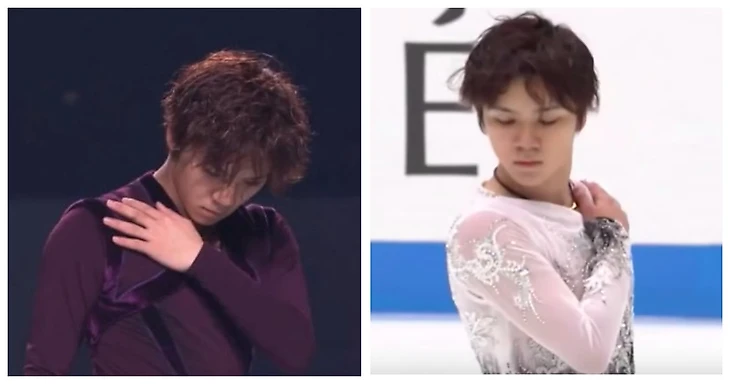
Стиль этой программы невозможно оторвать от музыкального материала, большая часть которого взята из первой части сонаты — той самой, которая навеяла романтическому поэту Рельштабу ассоциации с лунным пейзажем (сам Бетховен к этой «программе» не имеет никакого отношения). Ее медленный темп, лаконичный музыкальный язык и почти траурная ритмическая поступь определяют минималистичность выбранных хореографических средств, а также предельную серьезность и углубленность характера исполнения (и исполнителя). В этой программе минимум жестов, минимум открытой экспрессивности, но каждый жест и каждый поворот тела и даже головы мотивирован изгибами звуковой ткани. Перед исполнителем стоит непростая задача — не просто исполнить те жесты, которые поставлены хореографом, но и связать эти жесты, заполнить пространство между ними, не допустить их разрыва. Эта программа требует, с одной стороны, высокой культуры скольжения (для плавности всех переходов), с другой — музыкальной чуткости. Умения слушать музыку и заполнять тишину. Это делает ее абсолютно индивидуальной и объясняет, почему ни на ком другом, кроме Шомы, именно такой вариант Лунной сонаты никогда не прозвучал бы столь убедительно.
Основной выразительный инструмент здесь, без сомнения, красивые руки и очень гибкая верхняя половина корпуса, подчеркивающие едва ли каждый мелодический акцент музыки Бетховена, но соответствие музыкальному материалу достигается и музыкальностью расстановки самих элементов.
На этапах серии Гран-при начальная серия жестов, уже показанная выше на гифке, сменялась первым прыжковым элементом: четверным сальховом. В прокате на NHK получился, пожалуй, лучший вариант — как по качеству самого прыжка, так и по его вписанности в музыкальный материал за счет приземления точно на начало фразы в верхнем голосе:

Аналогичный эффект достигался и при исполнении следующего прыжка, флипа. На заходе движения рук обыгрывают каждый мелодический акцент, приземление же прыжка совпадает с важным поворотом в музыкальной ткани — появлением минорной гармонии после мажорного окончания предыдущей фразы.

За счет своей протяженности вращения создают более развернутые взаимоотношения движения и музыки. В двух подряд вращениях первой половины программы это соотношение выверено до долей секунды (из музыки пришлось даже вырезать одну долю в конце вращения в либеле). Помимо согласованности общих границ (начала и окончания), обращают на себя внимание отдельные выразительные детали: поднятие ноги в полу-бильман на мелодической вершине в первом вращении и, наоборот, «приседание» в волчок на выразительной гармонической детали (использовании низкой второй ступени) во втором.

Но эта программа дышит не только за счет грамотной вписанности «больших» элементов, но и благодаря едва заметным для непрофессионального уха деталям — мелким движениям и поворотам, как в зеркале отражающим детали музыкальной фразировки. Например, две фразы ниже разделены остановкой фигуриста и поворотом. Для того, чтобы так передать фразировку, нужно очень хорошо слушать и понимать музыку.

Минималистичность использованных средств, но одновременно с этим их предельно концентрированная выразительность — особенность и отдельных элементов программы. Яркий пример — хорео-секвенция, представляющая собой красивейший кораблик с охватом едва ли не половины катка.

Во время кораблика, начинающегося вместе с очередной мелодической фразой, все мелодические акценты, опять же, обыгрываются движениями рук, а завершается секвенция акцентированным движением корпуса и рук.
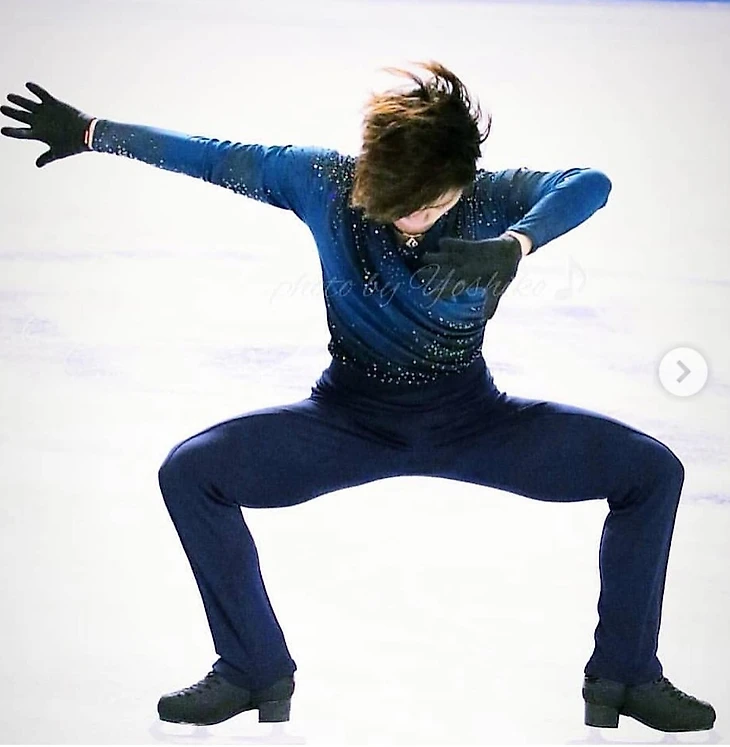
Кульминационная дорожка шагов под быстрый финал сонаты, помимо всех обязательных шагов и поворотов, включает в себя четыре ярких мелодических «взлета», каждый из которых получает соответствующий хореографический «акцент» в движениях рук и корпуса: сначала это два сходных движения рук (концовка первой и второй фраз), затем наклон головы (третья) и, наконец, очень выразительный вариант Ины Бауэр (четвертая).

Конец программы — комбинированное вращение, но интерес здесь вызывает не столько даже само вращение, сколько подход к нему в финале дорожки, в котором буквально одним шагом (крюк на левой ноге: LFO-LBO) и разворотом вокруг своей оси передается предельно скупая фактура — три звука в басовом голосе (смена направления движения на втором и разворот на третьем).

Этот заход делается на грани музыки и тишины, на тонкой границе слышимого и неслышного. В Лунной сонате Шомы это не единственный пример, демонстрирующий выразительный потенциал тишины — необходимость слушать даже то, что, кажется, уже нельзя услышать.
Слушать тишину
Выразительность пустот, о которой я сказал в начале поста — это особенность программы, обусловленная ее музыкальным материалом. В музыке Лунной сонаты немало остановок, пауз, разрывов музыкальной ткани, в которых постепенно растворяется динамический потенциал предшествующих фрагментов. Эти паузы всегда дышат, в них продолжается жизнь.
Один из примеров динамического использования тишины в программе — ойлерный каскад во второй половине. Бурный заход на первый прыжок словно бы «врезается» в резко акцентированный удар в басовом голосе. Такое окончание фразы дает импульс к началу элемента, который делается на фоне растворяющегося звука, уже почти в полной тишине. Только при приземлении с последнего прыжка музыка возобновляет свое движение, исчерпав потенциал паузы. Лучше всего эта тишина прозвучала на декабрьском чемпионате Японии.

Но самый выразительный момент в этом плане — тройной аксель, стоящий ровно между первой частью и финалом сонаты. На заходе музыка постепенно угасает, ее последний «вздох» подчеркивается выразительным жестом фигуриста, после чего в наступающей тишине раздается прыжок, динамика которого словно подхватывает и затем возобновляет остановившееся было музыкальное движение, перенося нас из первой части сонаты в финал.

* * *
Тишина окончательно покоряет музыку только в самом конце, когда угасают последние аккорды сонаты. Но в тот момент, когда границы художественного замыкаются последними жестами фигуриста, установившаяся было тишина вновь сменяется крикливой реальностью. Зрители, присутствовавшие на последнем прокате Лунной сонаты на ЧЧК, встают, кричат, аплодируют. Шома, только что выигрввший (как оказалось позднее) свой первый большой титул, падает на лед и с большим трудом переводит дыхание.
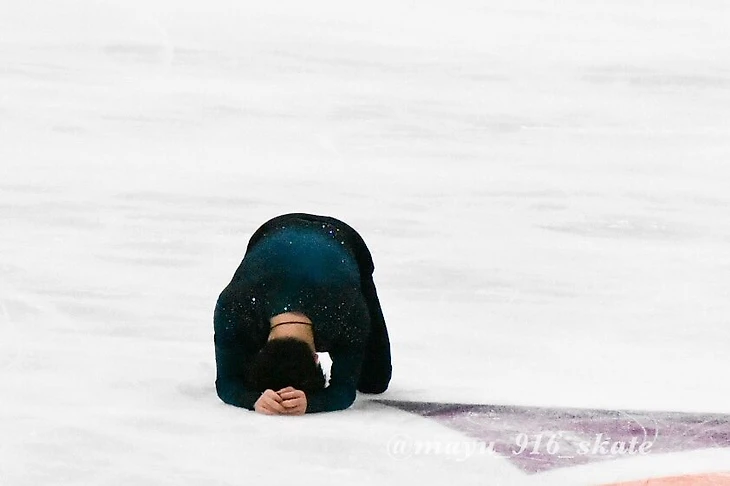
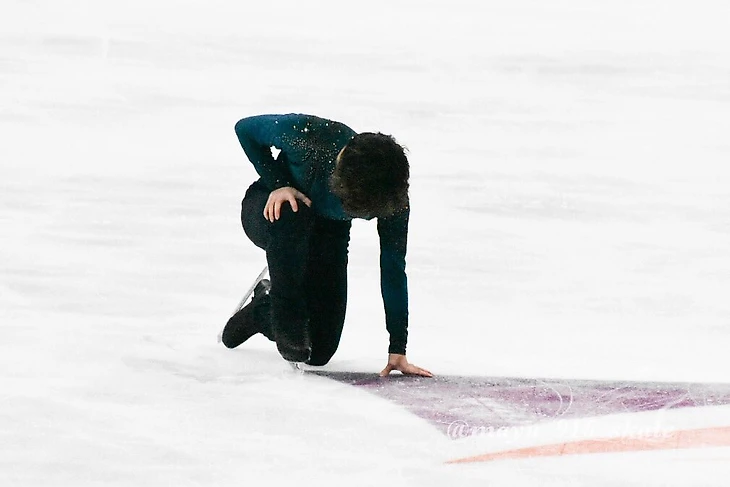
За четыре минуты программы, за красотой и легкостью ее исполнения, мы постепенно забываем, чего стоит вся эта красота и музыкальность, вся та огромная работа, которая преобразила программу за четыре с небольшим месяца, прошедших с момента ее первого показа на Ломбардии, и чего стоил тот победный прокат на фоне травмы.
Это, наверное, и есть то главное, о чем молчит "Лунная соната".
P.S. Сердечно благодарю пользователя Irina_Alchemist за разрешение использовать свой коллаж в обложке поста. Я благодарен пользователю goldenskate.com rabidline за вдохновляющие мысли об использовании тишины в программе Шомы Уно.
=====================================================================================
English translation
=====================================================================================
THE ELOQUENT SILENCE OF THE MOONLIGHT SONATA
The ugly duckling
The decision to skate his free program to Beethoven’s Moonlight sonata was met with a mixed response. On the one hand, there was no doubt that this music suited Shoma’s style, that he could skate to piano music. On the other—the chosen piece was way too popular in the figure skating world, so it was unclear what else could possibly be done with it what had not been done before, among other, by such skaters as Belousova-Protopopov, Gordeeva-Grinkov, Evgeniy Plushenko, Faiella-Scali, Sasha Cohen, Fumie Suguri, Akiko Suzuki, Daisuke Takahashi, and most recently by Papadakis-Cizeron.
These concerns only deepened after Shoma’s first showings of this program in the summer and then at the Lombardia trophy in September: the Moonlight sonata looked sloppy and practically empty. After watching it live in Bergamo, I passed the following verdict at the end of my overview of the event: ‘the choice of this particular music creates links with the long history of its use in figure skating, including last year by Gabriela Papadakis and Guillaume Cizeron, and this long history, in turn, generates a heavy weight of expectations. Meanwhile, it fails to meet these expectations and its future seems dim, which leaves a bitter taste of disappointment in the mouth.’
The sense of failure has also been fueled by a comparison of Moonlight sonata to the brilliant short program shown at the same competition, which seemed much stronger both choreographically and in terms of skating quality. The first half of the season, however, turned all these first impressions and conclusions upside down. At his both grand-prix assignments, Shoma struggled quite a bit with the short, to the extent that it had to be modified musically and choreographically. As a result, what seemed like a fully prepared program in September, surprisingly turned into a ‘work in progress’ in the following months. The Moonlight, on the other hand, started to bring impressive results from the very beginning of the Grand-Prix series.
At Skate Canada, the impressive skate of this program earned 188 points and brought the title despite a less than satisfying skate of the short a day before. The same pattern (unconvincing short and then a brilliant long) brought Shoma another two titles at the NHK Trophy in November and the Four Continents Championship in February. Even at the Grand-prix final, which Shoma did not win, the Moonlight sonata did not fail to impress, unlike his delivery of the short program.
It was the growth of this program that impressed most, however. What seemed ‘empty’ at the beginning has now been filled in—by sense and energy, not by other movements. There emerged a kind of magnetism essential for the program of this style and tempo. Most importantly, all movements were internalized and made his own by the skater himself. Shoma Uno turned this program into his own Moonlight sonata, as was promised at the beginning of the season. When he skated it at the Japanese Nationals in December, the program looked completely polished and ripe—even more so than the short which seemed to have had so much more potential at the beginning.
The essence of this growth becomes somewhat clearer when the two skates of this program (at the Lombardia and the Nationals) are put side by side. They look like two different programs: what was sharp, tense, and slightly forced in September became elegant, graceful, and flowy just two months later.

The ugly duckling turned into a beautiful swan midway through the season. And made many fans all around the world fall in love with it.
Listening to music
Shoma’s two competitive programs, as well as two exhibitions, stand in sharp contrast to each other: a fiery, fast, very intense, and extroversive short program skated to a mixture of Spanish and Latin-American rhythms—and a rarefied, more intimate and introversive, atmosphere and choreographic language of the Moonlight sonata. Even the fact that the starting pose of this program mirrors the beginning of the short, hints at them being created as one diptych on the one hand, and yet on the other foreshadows their opposition and contrast from the very beginning.

The choreographic content of the Moonlight is impossible to tear away from this program’s musical fabric, the major part of which is taken by the famous first movement—one that inspired Rellstab to give this sonata its nickname (‘Moonlight’). Its slow tempo, laconic musical language and almost funerary rhythmic profile define the minimalistic style of choreography used in Shoma’s program, as well as its seriousness and sophistication. Shoma’s Moonlight has a minimum amount of gestures and almost no open expressivity, but every gesture, every single turn of body or head, is motivated by folds in the musical fabric—little melodic or harmonic turns in Beethoven’s music.
The challenge that this program imposes on the skater is therefore not just about performing what is actually there in the program, but also filling in the space in-between, linking all those little gestures to each other, so that there are no perceived ruptures in the overall flow of the program. To make all the transitions smooth and imperceptible requires, first, excellent skating skills (which Shoma surely has); and second, musical sensitivity: the ability to listen to music and fill in the silence. What makes this program unique and explains why it would not suit any other skater except Shoma is precisely a combination of these two requirements.
The key to this program’s expressivity lies in how Shoma’s arms and upper body react to, express, and emphasize every singly melodic turn or accent in Beethoven’s music. Apart from that, a truly harmonious correlation between movement and music—with one naturally counterpointing another—is also accomplished by the positioning of all major elements of this program (jumps, spins, steps, etc.).
At the Grand-prix series, the first jumping pass that immediately followed the series of gestures shown above was the quadruple salchow. In terms of quality of its execution and musicality, the best version was shown at the NHK Trophy. Note how the landing of this jump emphasizes the beginning of the musical phrase:

A somewhat similar effect is achieved with the quadruple flip. While entering the jump, the skater accentuates the melody with his arms, and then synchronizes the landing with an important turn of events in the music: the appearance of the minor chord (E minor) after the end of the previous phrase in E major.

On account of their duration, spins create large-scale structural relationships between movement and music. In the first two spins that occur one after another in the first half of the program, these relationships are adjusted so that one beat of Beethoven’s music had to be cut out in order to accommodate the spin. Apart from that, note how in the first (camel) spin the highest note in the melody is emphasized by elevating the left leg in the half-Biellman position; and how in the second (flying change foot combination) spin the first sit position falls precisely on an important harmonic event (the appearance of the so-called Neapolitan sixth chord).

Movement and music are synchronized not just by the positioning of these ‘big’ elements, but also by subtle details that are almost imperceivable by an unprofessional ear: small gestures and turns that reflect, as in a mirror, the minute details of musical phrasing. The example below consists of two musical phrases separated by the skater’s deceleration and turn. This shows the high professional level of musical understanding both by the choreographer and the performer, who is able to hear the music and synchronize it accordingly with his movements.

The minimalistic choreographic style is evident both overall and in some individual elements of this program. The choreographic sequence (ChSq) is one brilliant example. It only includes a single spread eagle that covers almost one half of the rink, but its expressivity and its correlation with the music is yet again exceptional. It starts with a new musical phrase (on the upbeat) and the two following notes in the melody are emphasized by arms and upper body gestures.


The climactic step sequence (StSq) falls on the Finale of the sonata. Apart from all obligatory steps and turns, it incorporates four important melodic accents in a row, each receiving its choreographic equivalent in arm and body movements: two similar arm gestures (#1 and #2), a neck bend (#3) and, finally, a variation of the Ina Bauer (#4).

The program ends with another combination spin, but what is particularly interesting in terms of musicality is not so much the spin itself, as a few transitions that appear before it (in reality, this is the end of the step sequence), and that correspond to the three notes in the bass: a counter on the left foot (LFO-LBO) falls on the second note and then a turn of the whole body on the third.

This is one of a number of moments in this program which lie on that thin borderline between music and silence, and that illustrates the expressive potential of silence and the necessity to listen and perform not only to the music, but also to what seems to be barely audible.
Listening to silence
The expressiveness of pauses, that ‘fullness’ that I mentioned at the beginning, is closely related to the original Beethoven’s music. In the Moonlight sonata, there are many pauses, stops, melodic and harmonic ruptures that temporarily halt the musical development. These pauses, however, never cease to breathe, they never lose their dynamic potential—neither in the music itself, nor in Shoma’s program.
Shoma’s 3-jump combination is one of those examples that show how rests can be used dynamically, how their potential energy could be transformed into kinetic energy or motion. This combination is preceded by a vigorous passage that literally runs into a sharply accented octave in the bass. This abrupt ending provides a powerful impetus for the following jump combination, which unfolds in silence. It is only after the landing of the last jump is completed that the music resumes its motion.

Silence plays an important role earlier in the program as well, at the border between the first and last movements of the sonata, which are separated by Shoma’s first triple axel. During the entrance to this jump, music slowly fades away, its last breath emphasized by Shoma’s another arm movement. In the total silence that ensues, the skater jumps his axel, thereby creating a transition from one part of the program to another—transforming the silent end of the first movement into a connective tissue that links it to the newly emerging musical material.

* * *
Silence triumphs over music only at the very end, when the last chords of Beethoven’s Moonlight sonata die out. And yet this is precisely the moment when the purely artistic boundaries drawn by the skater’s last movements in his program are transgressed by the noisy reality: the audience that witnessed Shoma’s skate at the Four continents championship, stand up and start cheering and clapping. Shoma, who just won (as it turned out later) the first major title in his senior career, falls on the ice, unable to sustain pain and trying to catch his breath.


During these four minutes—while we were mesmerized by this program’s beauty and grace, by its seamless flow and sublime musicality, by its alternation of music and silence—we almost forgot the price paid for this beauty, for the tremendous development of this program in just four months or so. The price paid for skating with an injury.
This is perhaps the most important message to discern between the notes, in the eloquent silence of the Moonlight sonata.
P.S. I thank Irina_Alchemist for kindly giving me permission to use her collage. I extend my thanks to the GS user rabidline for insightful and inspirational comments on the use of silence in Shoma's Moonlight sonata.







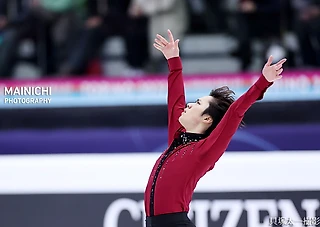
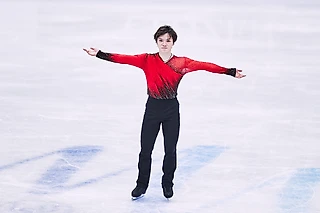
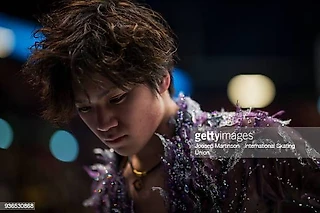
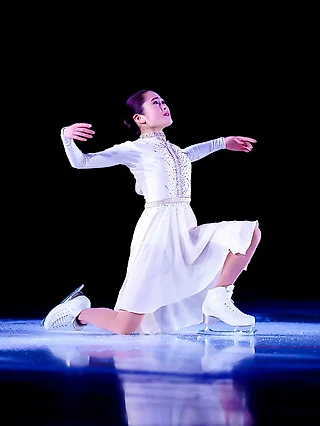
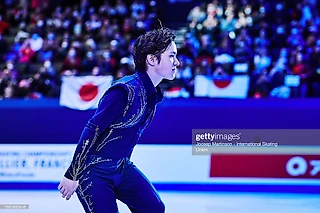
Спасибо!!!
Шома - прекрасный исполнитель! Спасибо за пост!
или пока нет соответствующиго ажиданиям проката?)
Ждем ЧМ и верим в режиссеров трансляции!
Всем добра, ума и пис!!!